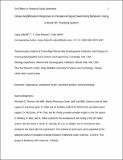Ocean acidification responses in paralarval squid swimming behavior using a novel 3D tracking system
Author(s)
Wirth, Colin; Mooney, T. Aran; Zakroff, Casey James
Download10750_2017_3342_ReferencePDF.pdf (2.385Mb)
PUBLISHER_POLICY
Publisher Policy
Article is made available in accordance with the publisher's policy and may be subject to US copyright law. Please refer to the publisher's site for terms of use.
Terms of use
Metadata
Show full item recordAbstract
Chronic embryonic exposure to ocean acidification (OA) has been shown to degrade the aragonitic statolith of paralarval squid, Doryteuthis pealeii, a key structure for their swimming behavior. This study examined if day-of-hatching paralarval D. pealeii from eggs reared under chronic OA demonstrated measurable impairments to swimming activity and control. This required the development of a novel, cost-effective, and robust method for 3D motion tracking and analysis. Squid eggs were reared in pCO[subscript 2] levels in a dose-dependent manner ranging from 400 to 2200 ppm. Initial 2D experiments showed paralarvae in higher acidification environments spent more time at depth. In 3D experiments, velocity, particularly positive and negative vertical velocities, significantly decreased from 400 to 1000 ppm pCO[subscript 2], but showed non-significant decreases at higher concentrations. Activity and horizontal velocity decreased linearly with increasing pCO[subscript 2], indicating a subtle impact to paralarval energetics. Patterns may have been obscured by notable individual variability in the paralarvae. Responses were also seen to vary between trials on cohort or potentially annual scales. Overall, paralarval swimming appeared resilient to OA, with effects being slight. The newly developed 3D tracking system provides a powerful and accessible method for future studies to explore similar questions in the larvae of aquatic taxa. Keywords: Hypercapnia, Cephalopod, Larvae, Movement analysis, Stress physiology
Date issued
2017-08Department
Joint Program in Oceanography; Woods Hole Oceanographic InstitutionJournal
Hydrobiologia
Publisher
Springer International Publishing
Citation
Zakroff, Casey, et al. “Ocean Acidification Responses in Paralarval Squid Swimming Behavior Using a Novel 3D Tracking System.” Hydrobiologia, vol. 808, no. 1, Feb. 2018, pp. 83–106.
Version: Author's final manuscript
ISSN
0018-8158
1573-5117